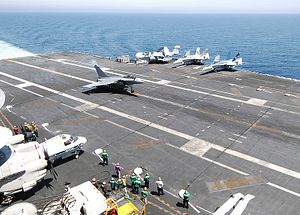The Indian Navy has officially issued a request for information (RFI) for a new carrier-based multirole warplane on January 17, according to IHS Jane’s Defense Weekly.
The Indian Navy intends to procure 57 naval fighter aircraft from a foreign supplier for its burgeoning fleet of aircraft carriers. As with previous defense deals, foreign aircraft makers are expected to assemble part of the new fleet of naval fighter jets in India under Indian Prime Minister’s Modi’s Make in India initiative.
The RFI lays out in detail the requirements for the new aircraft including “be capable of operations during day and night, and in all weather conditions; and be suitable for shipborne air defense, air-to-surface, ‘buddy-buddy’ aerial refueling, reconnaissance, electronic warfare, and other unspecified roles,” IHS Jane’s Defense Weekly notes. In terms of weapons systems the Indian Navy is looking for an aircraft that can carry four beyond visual-range air-to-air missiles (AAM), two shorter range AAMs and is fitted with a gun. The aircraft should also be capable of carrying strike weapons next to AAMs.
“Information requested includes whether the aircraft is single- or twin-seat (or available as both), and if it has one or two engines; whether it can perform Short Take-off But Arrested Recovery (STOBAR) or Catapult Take-off But Arrested Recovery (CATOBAR) operations (or both); whether the aircraft is already in operational use or not; whether helmet-mounted displays and large-area displays are integrated and fitted; is auto-landing an option; and whether or not an active electronically scanned array (AESA) radar is fitted.”
Responses are due by May 24. Delivery of the first aircraft is expected to begin three years following the inking of a contract and completed within three additional years. As I noted in December 2016 (See: “Indian Navy Rules out Tejas Fighter Jet on New Aircraft Carrier”), the Indian Navy will not deploy a naval version of the Hindustan Aeronautics Limited (HAL) Light Combat Aircraft Tejas aboard its new class of aircraft carriers.
The three likely contenders for the contract are Boeing’s F/A-18 Super Hornet, a naval version of the Dassault Rafale, and the Russian-made MiG-29K Fulcrum fighter jet. The Indian Navy already has two squadrons of MiG-29Ks stationed at two naval air stations and embarked on the aircraft carrier INS Vikramaditya, a modified Kiev-class aircraft carrier in service since 2013. The Indian Air Force has also purchased 36 off-the-shelf Rafale aircraft in a government-to-government deal in 2016.
As I explained elsewhere: “Representatives of French aircraft maker Dassault Aviation pitched the naval version of the Dassault Rafale twin-engine, fourth generation multirole fighter to the Indian Navy in early 2016. (The United States has been quietly pushing Lockheed Martin’s F-35c Lightning II and McDonnell Douglas F/A 18 Hornets).” The selection of the aircraft will depend to a certain degree what launch system will be used aboard the new carries currently under construction.
The INS Vikramaditya and INS Vikrant, India’s first indigenously built aircraft carrier, are both fitted with so-called ski-jump assisted Short Take-Off But Arrested Recovery (STOBAR) launch systems for launching aircraft, whereas the second carrier of the new Vikrant-class, the INS Vishal, will likely use a catapult assisted take-off but arrested recovery (CATOBAR) aircraft launch system, incorporating the new electromagnetic aircraft launch system (EMALS) technology (See: “Confirmed: India’s Next Aircraft Carrier Will Be Nuclear”).
“[The] STOBAR system imposes limits on the operational range and armament of aircraft operating from the carrier given that ski-jump takeoff and arrested carrier landings necessitate a high thrust-to-weight ratio for successful take-offs and can only be conducted with lightweight aircraft,” I explained elsewhere. The MiG-29K Fulcrum fighter jet is a STOBAR aircraft, whereas the F/A-18 and Rafale fighter jets can be launched with the CATOBAR launch system.
































